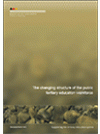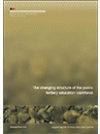This report provides an analysis that allows us to see how institutional strategies have evolved in the light of changing policy over the last ten years (2001 to 2011).
Key Results
- universities now employ a higher proportion of senior academic staff, in response to the greater focus on research performance
- universities have moved to more part-time teaching staff to help manage the costs of the shift to senior academic staff
- polytechnics now employ a higher proportion of principal lecturers due to the ‘drag effect’ of an ageing workforce, that is, people entering as lecturers and staying to become principal lecturers or deans/heads of school. Overall, the structure of the academic staff at polytechnics has not changed significantly
- universities also employ a higher proportion of professors due to the ‘drag effect’ of an ageing workforce, that is, people entering as lecturers and staying to become senior lecturers or professors.
- the universities and polytechnics now employ a similar proportion of part-time teaching staff
- wānanga now employ a higher proportion of full-time teaching staff
- the ratio of students to academic staff has increased across the sector, due to:
- changes in the enrolments pattern caused by the recent population bulge entering tertiary education
- increased tertiary education demand as a result of the continued high unemployment rates
- rising international enrolments
- a shift to higher-level and longer qualifications
- a shift towards a greater share of enrolments in more applied fields
- as a proportion of total staff, the academic staff employed by tertiary education institutions has remained stable.


